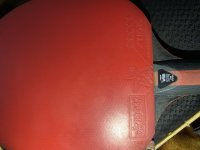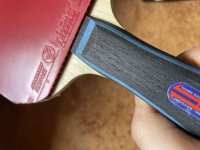Well that was a lot better than that first mystifying and silly comment. Here goes

Yes, no and maybe! All the kinetic energy is absorbed by the sponge, ball, top sheet and blade when the ball is stopped relative to the paddle. How the energy is absorbed in each is hard to determine. The energy returned depends on the elasticity of the ball, top sheet, sponge and blade. The blade doesn't absorb much energy. Celluloid balls absorb more than plastic balls. This is easy to determine by pressing on a celluloid ball until it dimples. This is harder to do with plastic balls.
So basically "Yes, but there's also X Y and Z". Sure, but that doesn't take away from the main point. The rubber is the most significant factor in storing energy and rebounding the ball. The ball itself is not a variable and therefore can be eliminated from the equation. You and your opponent use the same ball.
Besides, that little item was true but not so important. It was more to lead to the fact that the sponge is meant to impart spin/direction and why it is important for it to be able to store energy in order to do that.
Sweet
Yes, no and maybe. Harder sponges do not absorb as much energy. Again it is a ratio thing. All the energy is absorbed when the ball is stopped relative to the paddle. The question is where is the energy absorbed.
Yes it's a ratio, which is why to make the most of a harder sponge you have to be actively engaging it (or passively blocking, or whatever weird style you may play). It is not so much about speed with the sponge but more about the ability to control and spin the ball. You can have quite enough speed hitting the ball with a hardbat but that's not why sponges/rubbers were added.
Wouldn't density be determined by the ratio of sponge to pore volume?
Which, as I said, is generally attested to by the size of the pores. This is not the same as 'determines', because baguette bread can be very tough, yet have large air pockets while sponge cake is the opposite. With many soft sponges you will see visible pores and I haven't yet seen a hard TT sponge with really visible pores.
I guess you could theoretically extrude a 'sponge' from lead if you had the technology and of course some specialized sponges are made to completely dampen energy on the ball, but this is why I made sure to write 'generally'.
The ball doesn't hit the wood. The sponge may be compressed to the point where the sponge will not compress any more.
Most of us call this 'bottoming out' like bottoming out shocks.
Yeah ok, fair enough. For the purpose of the explanation it's easier to visualize that 'the ball compresses the rubber until it gets to the wood'. Of course the ball doesn't perforate the sponge.
Agreed but why aren't sponges rated like springs? There should be value like how many Newtons are required to compress a 1cm x 1cm sponge 0.1mm. The number probably will not be linear. It may take 3 times as many Newtons to compress a sponge 0.2mm. We don't know. Most of use do not care since people are very adaptable.
Well, I don't know why they're not rated like that. The compression set of sponges and rubbers is definitely calculable in principle as far as mathematics go... In engineering applications you mostly have to know the compression set because that's usually the most important thing for you in a sponge/rubber. Maybe it's just too complex, as you noted, for marketing purposes.
I think we have all played with new balls and have noticed the marks the new balls leave on the top sheet. The area of the white make on the top sheet indicates how much of the ball made contact with the sponge. I haven't done the calculations but there are two extreme cases. First assume the ball doesn't deform. It is possible to calculate how far the ball penetrates the rubber. The other extreme is to assume the rubber doesn't deform just the ball. The truth lies somewhere in between.
I have yet to see the ball get wrapped by the rubber or the top sheet. Both the ball and the rubber will deform. Again it is a ratio thing. No one knows because it is impossible to see with a high speed camera.
The ball deforms and is flexible or it would not bounce off the floor, so no worries there. But it is not as important, especially given you can treat the ball as fixed and not a variable.
Of course, as you said, it's hard to actually see the ball going into the softer and more flexible topsheet, but it's pretty obvious that this is what happens given the materials used, the method of their employment and the stated purpose thereof. The soft/flexible rubber is stretched like a trampoline across the pips, just as one example.
Why? This statement assume the sponge is better at returning energy than the ball, top sheet or blade.
If I put a softer and thick sponge on the paddle, do you expect it to play better? How?
I said what you generally want, ideally, is for the ball to come as close to bottoming the sponge out as possible.
The statement does not take into account the other variables at all since the item of discussion is the sponge and it's purpose

If you had nothing of the other stuff, that statement would still be a good guideline. At least when it comes to maximizing spin and direction control while having high speed.
802 1.5 mm SP must be uncontrollable. I have seen c-pen players use this and do very well at club leve.
Control is a function of player ability.
Forget about hard, soft, thick or thin. It is the elasticity that makes a difference when it comes to speed and spin.
While it is always true, I personally think it is irrelevant to involve player skill in a discussion about the properties of equipment because you, in essence, void the item of discussion completely. You may as well go into any blade/rubber review and write "This is all unimportant, the skill of the player is most important". It is true but of course all those blades/rubbers still have very different properties which are helpful to know and understand.
But the harder sponges will not let the balls sink into the rubber as far or as long. This violates #4 above.
[/QUOTE]
#4 was that you ideally want the ball to sink as much into the sponge as possible without it bottoming out (so as to be able to impart more spin, direction and speed, though speed is less the issue).
This, with a hard (dense) rubber, means more powerful strokes in order to compress the sponge. Which is why I said that hard sponges are better for the more advanced players who can hit hard but still with good technique so not to just slap the ball, but control and spin it.
It is true that with weak shots the ball will not engage the sponge properly and you will not have control or spin (which is part of why chinese rubbers are tacky), and therefore most rubbers commonly marketed in the west are medium and soft in comparison.












